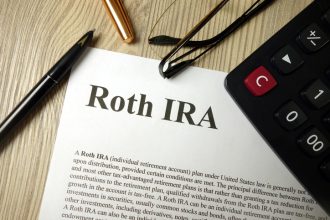Retirement planning in the United States offers a variety of options tailored to meet different financial goals and needs. You’ll most likely be familiar with 401(k)s and IRAs, which are two of the more common options, but we’ll also take a look at SEP IRAs, SIMPLE IRAs and Thrift Savings Plans, among others. Choosing the right retirement plan involves assessing your personal financial situation, future income expectations and retirement goals. Understanding the various options available can help you select a plan that aligns with your unique circumstances and aspirations.
A financial advisor can help you review your current financial situation and goals, and decide which options can help you get there.
Types of Retirement Plans in the USA
Whether you’re seeking the employer match of a 401(k), the tax-deferred growth of an IRA, or the guaranteed income of a pension plan, there’s a retirement plan designed to meet your financial needs and retirement objectives. Here’s a roundup of eight common retirement plans.
401(k) Plans
401(k) plans are one of the most common retirement plans, primarily offered by employers to their employees. These plans allow employees to contribute a portion of their pre-tax income, which then grows tax-deferred until retirement. Employers often match a portion of the contributions, which can significantly boost retirement savings. This plan is especially suitable for employees who have access to an employer-sponsored retirement program and want to benefit from potential employer contributions.
Individual Retirement Accounts (IRAs)
IRAs are popular retirement plans in the USA for individuals seeking flexible retirement savings options. There are two main types of IRAs: Traditional IRAs and Roth IRAs. Traditional IRAs offer tax-deferred growth, meaning contributions are tax-deductible in the year they are made, and taxes are paid upon withdrawal in retirement. Roth IRAs, conversely, are funded with after-tax dollars, allowing for tax-free withdrawals in retirement. Traditional IRAs are ideal for individuals who expect to be in a lower tax bracket during retirement, while Roth IRAs are more suitable for those who anticipate being in a higher tax bracket.
Simplified Employee Pension (SEP) IRAs
SEP IRAs are designed for self-employed individuals and small business owners. These plans allow for higher annual contribution limits compared to traditional IRAs, based on a percentage of the employee’s income. Contributions are tax-deductible for the business, and the funds grow tax-deferred until retirement. SEP IRAs are particularly advantageous for self-employed individuals who have fluctuating incomes and want the flexibility to adjust their contributions each year.
Savings Incentive Match Plan for Employees (SIMPLE) IRAs
SIMPLE IRAs are another type of retirement plan available in the USA, tailored for small businesses with 100 or fewer employees. This plan allows both employers and employees to make contributions. Employees can defer a portion of their salary, while employers are required to either match employee contributions up to a certain percentage or make non-elective contributions. SIMPLE IRAs are beneficial for small businesses looking to offer retirement benefits without the complexity of a 401(k) plan.
Thrift Savings Plan (TSP)

The TSP is a retirement savings plan for federal employees and members of the uniformed services, including the Ready Reserve. The TSP offers low-cost investment options and similar tax advantages to those found in 401(k) plans, including traditional (pre-tax) and Roth (after-tax) contribution options. The plan also features lifecycle funds, which automatically adjust the investment mix based on the participant’s age and retirement goals. The TSP is ideal for government employees seeking a straightforward, low-cost retirement savings vehicle.
403(b) Plans
403(b) plans are similar to 401(k) plans but are designed for employees of public schools, certain non-profits and tax-exempt organizations. Contributions to 403(b) plans are made on a pre-tax basis, reducing taxable income and the investments grow tax-deferred until retirement. These plans often include investment options like annuities and mutual funds. 403(b) plans are suitable for educators, healthcare workers and employees of non-profit organizations seeking to build a tax-advantaged retirement nest egg.
457 Plans
457 plans are deferred compensation retirement plans available to state and local government employees and certain non-profit organizations. These plans allow participants to contribute a portion of their salary on a pre-tax basis, similar to 403(b) and 401(k) plans. One unique feature of 457 plans is the lack of an early withdrawal penalty for distributions taken before age 59½, though regular income taxes still apply. This makes 457 plans attractive for government employees who may need more flexible access to their funds before retirement age.
Defined Benefit Pension Plans
Defined benefit pension plans, often simply called pension plans, provide retirees with a guaranteed monthly income based on factors such as salary history and years of service. These plans are less common today, but are still offered by some government employers and large corporations. Unlike defined contribution plans like 401(k)s, the employer bears the investment risk and is responsible for ensuring that there are sufficient funds to pay out the promised benefits. Defined benefit pension plans are ideal for employees who prefer a predictable, stable retirement income and are typically found in long-term public sector or large corporate jobs.
Bottom Line

With the variety of retirement plans available, individuals can find options that best suit their employment situations and retirement goals. 401(k)s, 403(b)s and 457 plans offer significant tax advantages and are often accompanied by employer contributions, enhancing savings growth. IRAs provide flexibility and tax benefits for those without employer-sponsored plans. SEP IRAs and SIMPLE IRAs cater to the needs of small business owners and self-employed individuals, while defined benefit pension plans offer stability and predictability for retirees.
Retirement Plan Tips
- If you need help determining which retirement plan best aligns with your financial situation, an advisor can help you create a personalized plan. Finding a financial advisor doesn’t have to be hard. SmartAsset’s free tool matches you with up to three vetted financial advisors who serve your area, and you can have a free introductory call with your advisor matches to decide which one you feel is right for you. If you’re ready to find an advisor who can help you achieve your financial goals, get started now.
- During the retirement planning process, it’s important to think about the retirement tax laws of the state you want to retire in. By minimizing your retirement tax burden, you can maximize the value of your savings in retirement.
Photo credit: ©iStock.com/designer491, ©iStock.com/shapecharge, ©iStock.com/dmbaker
Read the full article here
















